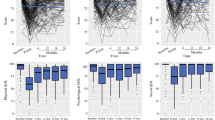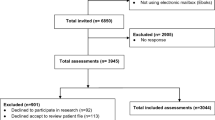Abstract
Purpose
The purpose was to compare progression/regression of arm lymphoedema, health-related quality of life and medical background data among women who discontinued their treatment (non-continued treatment group, NCTG) with these factors among women who continued treatment (continued treatment group, CTG).
Methods
Seventy-two women were included in the NCTG and 58 women in the CTG. Women in the NCTG were invited to an examination and measurement of affected arm volume at the clinic in 2008. Medical background data and arm volume values, measured using the water displacement method, were collected from patient records and the Breast Cancer Quality Register of the Uppsala Örebro Region. The functional assessment of cancer therapy for breast cancer (FACT-B) was used to assess health-related quality of life in both groups.
Results
There were no differences with regard to progression/regression of arm lymphoedema or health-related quality of life. The CTG had experienced more advanced disease and received more extensive surgical and oncological treatment. The CTG had significantly larger arm volume due to lymphoedema at diagnosis (mean 422 ml) compared to the NCTG (mean 283 ml; p < 0.001), and at the last visit at the clinic (CTG mean 414 ml versus NCTG mean 239 ml; p < 0.001).
Conclusions
The results indicate that there might be a spontaneous regression of lymphoedemas in the NCTG but there is a need for more research to make it possible to draw firm conclusions regarding this.

Similar content being viewed by others
References
National Board of Health and Welfare (2012) Cancer incidence in Sweden 2011. Stockholm
Walters S, Maringe C, Butler J, Rachet B, Barret Lee P, Bergh J et al (2013) Breast cancer survival and stage at diagnosis in Australia, Canada, Denmark, Norway, Sweden and the UK 2000–2007: a population-based study. Br J Cancer 108:1195–1208
Rietman JS, Dijkstra PU, Hoekstra HJ, Eisma WH, Szabo BG, Groothoff JW et al (2003) Late morbidity after treatment of breast cancer in relation to daily activities and quality of life: a systematic review. Eur J Surg Oncol 29:229–238
Johansson K, Branje E (2010) Arm lymphoedema in cohort of breast cancer survivors 10 years after diagnosis. Acta Oncol 49:166–173
Tsai RJ, Dennis LK, Lynch CF, Snetselaar LG, Zamba GK, Scott-Connor C (2009) The risk of developing arm lymphedema among breast cancer survivors: a meta analysis of treatment factors. Ann Surg Oncol 16:1959–1972
McLaughlin S, Wright M, Morris K, Sampson M, Brockway J, Hurley K et al (2008) Prevalence of lymphedema in woman with breast cancer 5 years after sentinel lymph node biopsy or axillary dissection: patient perceptions and precautionary behaviours. J Clin Oncol 26:5220–5226
Armer J, Stewart B, Shook R (2009) 30 month post breast cancer treatment lymphoedema. J Lymphoedema 4:14–18
Miller A, Bruna J, Beninson J (1999) A universally applicable clinical classification of lymphedema. Angiology 50:189–192
Földi E (1998) The treatment of lymphoedema. Cancer 15:2833–2834
Ramos S, O’Donnell L, Knight G (1999) Edema volume, not timing, is the key to success in lymhedema treatment. Am J Surg 178:311–315
Stout-Gergerich NL, Pfalzer LA, McGarvey C, Springer B, Gerber LH, Soballe P (2008) Preoperative assessment enables the early diagnosis and successful treatment of lymphedema. Cancer 112:2809–2819
Földi E, Földi M, Weissleder H (1985) Conservative treatment of lymhoedema of the limbs. Angiology 36:171–180
Casley-Smith JR (1995) Alterations of untreated lymphedema and its grades over time. Lymphology 28:174–185
Brorson H, Ohlin K, Olsson G, Nilsson M (2006) Adipose tissue dominates chronic arm lymphedema following breast cancer: an analysis using volume rendered CT images. Lymphat Res Biol 4:199–210
Morgan P, Franks P, Moffatt C (2005) Health-related quality of life with lymphoedema: a review of literature. Int Wound J 2:47–62
Bernas M, Witte M, Witte C, Belch D, Summers P (1996) Limb volume measurements in lymphedema issues and standards. Lymphology 29(suppl):199–202
Godal R, Swedborg I (1982) A correction for the natural asymmetry of the arms in the determination of the volume of oedema. Scand J Rehabil Med 14:193–195
Brady M, Cella D, Mo F, Bouomi A, Tulsky D, Lloyd S et al. (1997) Reliability and validity of the functional assessment of cancer therapy-breast-quality-of-life instrument. J Clin Oncol 15:974–986. http://www.facit.org
Bonomi AE, Cella DF, Hahn EA, Bjordal K, Sperner-Unterweger B, Gangeri L et al (1996) Multilingual translation of the functional assessment of cancer therapy (fact) quality of life measurement system. Qual Life Res 5:309–320
Cella D (1997) Manual of the Functional Assessment of Chronic Illness Therapy ( FACIT) Measurement system Version 4. CORE, Evanston Northwestern Healthcare, Evanston I, 1997
Hwang MJ, Hwang HJ, Kim WT, Lee YS, Chang JH, Chu HI (2013) Long-term effects of complex decongestive therapy in breast cancer patients with arm lymphedema after axillary dissection. Ann Rehabil Med 37:690–697
Bar Ad V, Cheville A, Solin LJ, Dutta P, Both S, Harris ER (2010) Time course of mild lymphedema after breast conservation treatment for early-stage breast cancer. Int J Radiat Oncol Biol Phys 76:85–90
Johansson K, Holmström H, Nilsson I, Ingvar C, Albertsson M, Ekdahl C (2003) Breast cancer patients’ experiences of lymphoedema. Scand J Caring Sci 17:35–42
Specht MC, Miller CL, Russel TA, Horick N, Skolny MN, O’Toole JA et al (2013) Defining a threshold for intervention in breast cancer-related lymphedema: what level of arm volume increase predicts progression? Breast Cancer Res Treat 140:485–494
Mahamaneerat WK, Shyu C-R, Stewart BR, Armer JM (2008) Breast cancer treatment, BMI, postop swelling/lymphedema. J Lymphoedema 3:38–44
Dawes D, Meterissian S, Goldberg M, Mayo N (2008) Impact of lymphoedema on arm function and health-related quality of life in women following breast cancer surgery. J Rehabil Med 40:651–658
Koinberg I, Langius-Eklöf A, Holmberg L, Fridlund B (2006) The usefulness of a multidisciplinary educational programme after breast cancer surgery: a prospective and comparative study. Eur J Oncol Nurs 10:273–282
Acknowledgments
We wish to thank the Swedish Oedema Association and the Research Foundation of the Department of Oncology at Uppsala University for sponsoring the study.
Conflict of interest
None to declare.
Author information
Authors and Affiliations
Corresponding author
Rights and permissions
About this article
Cite this article
Karlsson, K.Y., Wallenius, I., Nilsson-Wikmar, L.B. et al. Lymphoedema and health-related quality of life by early treatment in long-term survivors of breast cancer. A comparative retrospective study up to 15 years after diagnosis. Support Care Cancer 23, 2965–2972 (2015). https://doi.org/10.1007/s00520-015-2662-4
Received:
Accepted:
Published:
Issue Date:
DOI: https://doi.org/10.1007/s00520-015-2662-4




